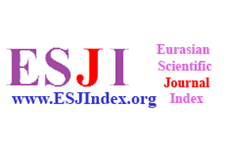Relationship between Bitcoin dynamics and energy futures quotes as a possible tool of choice for the implementation of startups
Oleg Vasiurenko
Department of Cybersecurity, IT and Economics, Kyiv University of Intellectual Property and Law, Kyiv, Ukraine
Oleksandr Bilotserkivskyi
Department of Business, Trade and Logistics, National Technical University «Kharkiv Polytechnic Institute», Ukraine
Yevhen Zastola
Department of Business, Trade and Logistics, National Technical University «Kharkiv Polytechnic Institute», Ukraine
Keywords: Comparison, Tool, Analysis, Quotes, Bitcoin, Startup, Dynamics, Futures, Securities Market, Source of Funding
Abstract
Startups are a new form of implementing various business ideas. This form of business organization allows you to quickly and efficiently find the necessary solutions for a number of different problems and implement business ideas in the shortest possible time. However, this is a risky business that requires significant financial resources. One source of such resources may be the stock market. The cryptocurrency market and the energy market attract particular attention in this matter. Therefore, it is important to know the best times to enter these markets. Moreover, such markets can be potential consumers of startup services. Based on this, analyzing the relationship between Bitcoin dynamics and energy futures quotes is a promising area of research. The paper presents the dynamics of quotes for Bitcoin and energy futures. An analysis of their mutual dynamics is carried out. The results are presented in the form of separate graphs and diagrams. This helps to understand the progress of this study.
References
Bortolini, R. F., Nogueira Cortimiglia, M., Danilevicz, A. D. M. F., & Ghezzi, A. (2021). Lean Startup: a comprehensive historical review. Management Decision, 59(8), 1765-1783.
Skala, A., & Skala, A. (2019). The startup as a result of innovative entrepreneurship. Digital Startups in Transition Economies: Challenges for Management, Entrepreneurship and Education, 1-40.
Magalhães, R. P. C. (2019). What is a startup?: a scoping review on how the literature defines startup (Doctoral dissertation).
Lyashenko V. Wavelet Analysis Methodology as a Tool for Predicting Cryptocurrency Price Dynamics / V. Lyashenko, O. Sergienko, S. Stepurina // International Journal of Academic Management Science Research (IJAMSR). – 2021. – Vol. 5. – Issue 12. – P. 45-52.
Petrukhnov O. V. Development of the Energy Sector in the Display of Key Exchange Indices / O. V. Petrukhnov, A. V. Negliad, V. Lyashenko // International Journal of Academic Management Science Research. – Vol. 7(6). – P. 69-75.
Baranova, V., Zeleniy, O., Deineko, Z., & Lyashenko, V. (2019, October). Stochastic Frontier Analysis and Wavelet Ideology in the Study of Emergence of Threats in the Financial Markets. In 2019 IEEE International Scientific-Practical Conference Problems of Infocommunications, Science and Technology (PIC S&T) (pp. 341-344). IEEE.
Kuzemin, A., & Lyashenko V. (2011). Microsituation Concept in GMES Decision Support Systems. In Intelligent Data Processing in Global Monitoring for Environment and Security, 217–238.
Lyashenko, V., Deineko, Z., & Ahmad, A. (2015). Properties of Wavelet Coefficients of Self-Similar Time Series. International Journal of Scientific and Engineering Research, 6, 1492-1499.
Tvoroshenko, I., Ahmad, M. A., Mustafa, S. K., Lyashenko, V., & Alharbi, A. R. (2020). Modification of models intensive development ontologies by fuzzy logic. International Journal of Emerging Trends in Engineering Research, 8(3), 939-944.
Dadkhah, M., Lyashenko, V. V., Deineko, Z. V., Shamshirband, S., & Jazi, M. D. (2019). Methodology of wavelet analysis in research of dynamics of phishing attacks. International Journal of Advanced Intelligence Paradigms, 12(3-4), 220-238.
Азаренкова, Г., & Ляшенко, В. (2009). Відношення переваг у порівняльній оцінці діяльності банків. Банківська справа, 5, 65-72.
Lyashenko, V. (2014). Efficiency of bank crediting of real sector of economy in the context of separate banking groups: an empirical example from Ukraine. International Journal of Accounting and Economics Studies, 2(2), 74-79.
Ляшенко В. В. (2007). Интерпретация и анализ статистических данных, описывающих процессы экономической динамики. Бизнес Информ, 9(2), 108-113.
Kuzemin, A., & Lyashenko, V. (2009). Methods of comparative analysis of banks functioning: classic and new approaches. Information Theories & Applications, 16(4), 384-396.
Куштим, В. В., & Ляшенко, В. В. (2007). Динаміка розвитку банківського сегмента міжнародного фінансового ринку. Фінанси України, (12), 96-105.
Kuzemin, A., & Lyashenko, V. (2006). Fuzzy set theory approach as the basis of analysis of financial flows in the economical security system. International Journal Information Theories & Applications, 13(1), 45-51.
Omarov, M., Tikhaya, T., & Lyashenko, V. (2019). Internet marketing metrics visualization methodology for related search queries. International Journal of Advanced Trends in Computer Science and Engineering, 8(5), 2277-2281.
Vasiurenko, O., Lyashenko, V., Baranova, V., & Deineko, Z. (2020). Spatial-Temporal Analysis the Dynamics of Changes on the Foreign Exchange Market: an Empirical Estimates from Ukraine. Journal of Asian Multicultural Research for Economy and Management Study, 1(2), 1-6.
Dadkhah, M., Lyashenko, V., & Jazi, M. (2015). Methodology of the Chaos Theory in research of phishing attacks. International Journal of Academic Research, 7(1), 169-175.
Mousavi, S. M. H., Victorovich, L. V., Ilanloo, A., & Mirinezhad, S. Y. (2022, November). Fatty Liver Level Recognition Using Particle Swarm optimization (PSO) Image Segmentation and Analysis. In 2022 12th International Conference on Computer and Knowledge Engineering (ICCKE) (pp. 237-245). IEEE.
Lyashenko, V., Zeleniy, O., Mustafa, S. K., & Ahmad, M. A. (2019). An advanced methodology for visualization of changes in the properties of a dye. International Journal of Engineering and Advanced Technology, 9(1), 711-7114.
Klačmer Čalopa, M., Horvat, J., & Lalić, M. (2014). Analysis of financing sources for start-up companies. Management: journal of contemporary management issues, 19(2), 19-44.
Smus, T. R. (2017). Sources of support anD funding innovative start-ups. International solutions. Kwartalnik Naukowy Uczelni Vistula, (2 (52), 127-142.
Bauer, D., Junge, S., & Reif, T. (2023). May the resources be with you: a systematic review and framework of startup funding options. Management Review Quarterly, 1-32.
Binh, K. B., Jhang, H., Park, D., & Ryu, D. (2020). Capital markets for small-and medium-sized enterprises and startups in Korea. The Journal of Asian Finance, Economics and Business, 7(12), 195-210.
Elia, G., & Quarta, F. (2020). Financing the development of technology startups. Innovative Entrepreneurship in Action: From High-Tech to Digital Entrepreneurship, 93-114.
Jaladati, H., & Chitsaz, E. (2022). An Overview of Cryptocurrency-based Crowdfunding for Startups. Available at SSRN 4099802.
Ahluwalia, S., Mahto, R. V., & Guerrero, M. (2020). Blockchain technology and startup financing: A transaction cost economics perspective. Technological Forecasting and Social Change, 151, 119854.
Torrence, С., & Webster, P. J. (1999). Interdecadal changes in the ENSO–monsoon system. Journal of climate, 12(8), 2679-2690.
Heil, C.E., & Walnut, D.F. (1989). Continuous and discrete wavelet transforms. SIAM review, 31(4), 628- 666.
Kingsbury, N. (1999). Image processing with complex wavelets. Philosophical Transactions of the Royal Society of London. Series A: Mathematical, Physical and Engineering Sciences, 357(1760), 2543-2560.
Vasiurenko, O., & Lyashenko, V. (2020). Wavelet coherence as a tool for retrospective analysis of bank activities. Economy and Forecasting, (2), 43-60.
Baranova, V., Orlenko, O., Vitiuk, A., Yakimenko-Tereschenko, N., & Lyashenko, V. (2020). Information system for decision support in the field of tourism based on the use of spatio-temporal data analysis. International Journal of Advanced Trends in Computer Science and Engineering, 9(4), 6356-6361.
Dadkhah, M., Lyashenko, V., & Jazi, M. (2015). Methodology of the Chaos Theory in research of phishing attacks. International Journal of Academic Research, 7(1), 169-175.
Vyacheslav, L., Omer, I. A. M., & Asaad, M. A. B. (2020). COVID-19 wavelet coherence data for some Gulf countries. GSC Biological and Pharmaceutical Sciences, 11(2), 166-174.
Orhan, A., Kirikkaleli, D., & Ayhan, F. (2019). Analysis of wavelet coherence: service sector index and economic growth in an emerging market. Sustainability, 11(23), 6684.
Kirikkaleli, D., & Gokmenoglu, K. K. (2020). Sovereign credit risk and economic risk in Turkey: empirical evidence from a wavelet coherence approach. Borsa Istanbul Review, 20(2), 144-152.
Wang, Y., Wei, M., Bashir, U., & Zhou, C. (2022). Geopolitical risk, economic policy uncertainty and global oil price volatility—an empirical study based on quantile causality nonparametric test and wavelet coherence. Energy Strategy Reviews, 41, 100851.

















